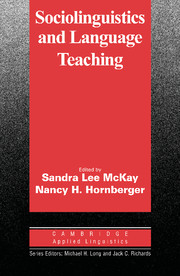Book contents
- Frontmatter
- Contents
- List of contributors
- Series editors' preface
- Preface
- Acknowledgements
- Part I LANGUAGE AND SOCIETY
- Part II LANGUAGE AND VARIATION
- Part III LANGUAGE AND INTERACTION
- 8 Ethnographic microanalysis
- 9 Interactional sociolinguistics
- 10 Intercultural communication
- Part IV LANGUAGE AND CULTURE
- CONCLUSION
- Index
9 - Interactional sociolinguistics
Published online by Cambridge University Press: 22 July 2009
- Frontmatter
- Contents
- List of contributors
- Series editors' preface
- Preface
- Acknowledgements
- Part I LANGUAGE AND SOCIETY
- Part II LANGUAGE AND VARIATION
- Part III LANGUAGE AND INTERACTION
- 8 Ethnographic microanalysis
- 9 Interactional sociolinguistics
- 10 Intercultural communication
- Part IV LANGUAGE AND CULTURE
- CONCLUSION
- Index
Summary
Introduction
Interactional sociolinguistics is a theoretical and methodological perspective on language use that is based in linguistics, sociology, and anthropology. Because of these disciplinary roots, it shares the concerns of all three fields with language, society, and culture. Although speech act theory (Cohen, this volume), the ethnography of communication (Saville-Troike, this volume) and microethnography (Erickson, this volume) are also concerned with language, society, and culture, the approach discussed in this chapter is somewhat different in theory, method, origin, and focus (see Schiffrin, 1992, 1994, Chaps. 3 to 5).
The discussion in this chapter begins with the contributions of the sociologist Erving Goffman (see Erickson, this volume). Goffman's analysis of face-to-face interaction provide an understanding of how language is situated in particular circumstances of social life and how it both reflects and adds meaning and structure to those circumstances. Next, the contributions of the linguistic anthropologist John Gumperz are discussed (see Chick, this volume). Gumperz's analyses of verbal communication help us understand how people may share grammatical knowledge of a language but differently contextualize what is said, in such a way that very different messages are produced and understood. The ideas of these two scholars are highlighted because so many contemporary analyses of the language of social interaction are guided by the underlying assumptions, theories, and methods provided by their work.
- Type
- Chapter
- Information
- Sociolinguistics and Language Teaching , pp. 307 - 328Publisher: Cambridge University PressPrint publication year: 1995
- 5
- Cited by



